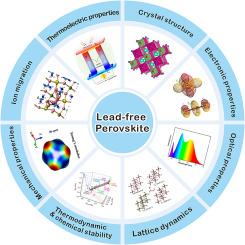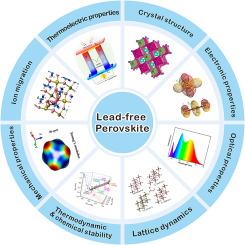Recent advances of theoretical investigation on lead-free metal halide perovskites
IF 23.5
1区 化学
Q1 CHEMISTRY, INORGANIC & NUCLEAR
引用次数: 0
Abstract
Metal halide perovskites (MHPs) have aroused as promising candidates in diverse applications, however, the widespread use of Pb-based MHPs is troubled by issues of toxicity and instability. This has spurred significant research efforts to develop Pb-free alternatives with comparable or superior properties. Theoretical investigations play a critical role in this pursuit, offering unparalleled insights into material behaviors at microscopic spatial scales and ultrafast timescales. This review presents a thorough discussion of the theoretical advancements in Pb-free MHPs, encompassing their crystal structures, electronic properties, optical properties, the lattice dynamics, thermodynamic and chemical stability, mechanical properties, ion migration and thermoelectric properties, and the advantages of theoretical means and their vital role in understanding and optimizing the properties of Pb-free MHPs are systematically highlighted. Furthermore, this review identifies the current challenges and outlines potential directions for advancing the field, offering inspiration for innovation. This work aims to accelerate the replacement of Pb-based MHPs by Pb-free alternatives, fostering the development of sustainable, high-performance Pb-free MHPs for future applications.


无铅金属卤化物钙钛矿理论研究进展
金属卤化物钙钛矿(MHPs)在各种应用中都有很好的应用前景,然而,基于pb的MHPs的广泛使用受到毒性和不稳定性问题的困扰。这刺激了重大的研究努力,以开发具有相当或更好的性能的无铅替代品。理论研究在这一追求中发挥着关键作用,为微观空间尺度和超快时间尺度上的材料行为提供了无与伦比的见解。本文从晶体结构、电子性质、光学性质、晶格动力学、热力学和化学稳定性、力学性质、离子迁移和热电性质等方面综述了无铅MHPs材料的理论研究进展,并系统地介绍了理论方法的优点及其在理解和优化无铅MHPs材料性能中的重要作用。此外,本文还指出了当前的挑战,并概述了推进该领域的潜在方向,为创新提供了灵感。这项工作旨在加速以无铅替代品取代基于铅的MHPs,促进可持续、高性能的未来应用的无铅MHPs的发展。
本文章由计算机程序翻译,如有差异,请以英文原文为准。
求助全文
约1分钟内获得全文
求助全文
来源期刊

Coordination Chemistry Reviews
化学-无机化学与核化学
CiteScore
34.30
自引率
5.30%
发文量
457
审稿时长
54 days
期刊介绍:
Coordination Chemistry Reviews offers rapid publication of review articles on current and significant topics in coordination chemistry, encompassing organometallic, supramolecular, theoretical, and bioinorganic chemistry. It also covers catalysis, materials chemistry, and metal-organic frameworks from a coordination chemistry perspective. Reviews summarize recent developments or discuss specific techniques, welcoming contributions from both established and emerging researchers.
The journal releases special issues on timely subjects, including those featuring contributions from specific regions or conferences. Occasional full-length book articles are also featured. Additionally, special volumes cover annual reviews of main group chemistry, transition metal group chemistry, and organometallic chemistry. These comprehensive reviews are vital resources for those engaged in coordination chemistry, further establishing Coordination Chemistry Reviews as a hub for insightful surveys in inorganic and physical inorganic chemistry.
 求助内容:
求助内容: 应助结果提醒方式:
应助结果提醒方式:


